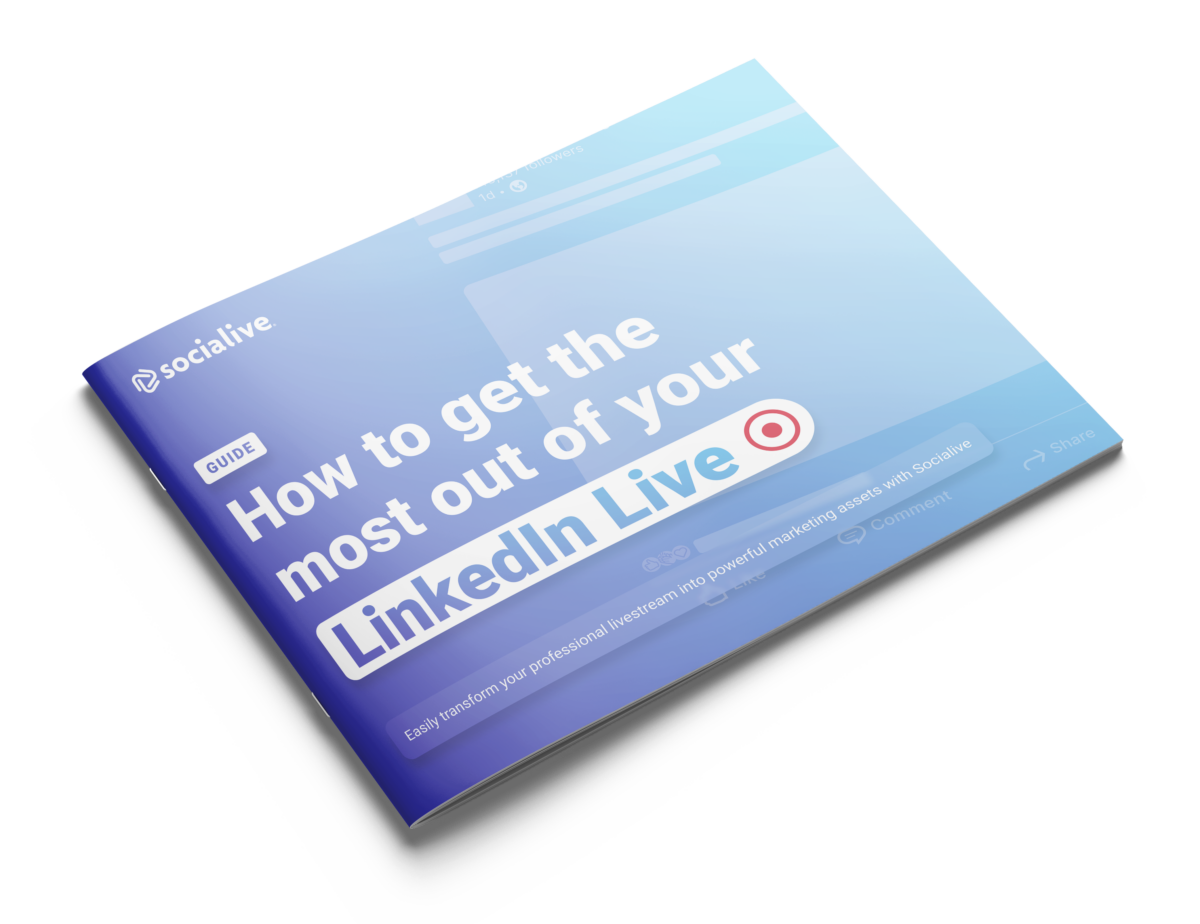Livestreaming can be as simple as picking up your smartphone and going live. But if you want it to look and sound professional, we recommend dedicating some time to plan.
Whether a live Q&A with thought leaders or a virtual conference, a strategic, well-planned live video can grow your brand and enable you to reach a wider audience.
Going live — or even preparing for a recording session — can be intimidating, but it doesn’t have to be. We dive deeper into some tips that help talent feel comfortable and confident in another post on guiding thought leaders on camera.
For those who are in a bit more of a do-it-all role and have to be both producer and presenter, here are nine tips to help you prepare for a successful livestream.
1. Define the goal of your livestream
What are you trying to achieve in your live broadcast? Decide what you want to accomplish. Whether to grow your audience, generate leads, or improve sales, the first step is to nail down your objective.
Knowing your purpose before going live will help you shape what your broadcast will look like. For example, if your goal is to improve sales, you may want to unveil a new product or service in the broadcast. This makes it much easier to repurpose the livestream as demand-gen content, such as ads or demos, after the event.
2. Select your topic
Decide what topic you want to cover and what type of conversation you want to have with your audience. Speaking knowledgeably about the topic will help you manage the broadcast with confidence.
After choosing a topic, determine the format. It could be a question-and-answer session, a how-to video, interviews, behind-the-scenes content, or product and service reveals.
3. Determine your target destination(s)
When deciding what channels to broadcast to, keep your goal in mind. Who is your target audience, and where do they live? Are they on social media channels such as Facebook, Twitter, LinkedIn, Instagram, YouTube, or all five?
With Socialive, you can broadcast to the above social media channels: Amazon, Microsoft Teams, Workplace by Facebook, ON24, Wix, Vimeo, Brightcove, Qumu, and Yammer. There is no limit to the number of channels you can simulcast to.
Once you have decided on your streaming destination(s), figure out an optimum time for going live. Consider time zones, work schedules, and other factors that could prevent your audience from tuning in.
Pro-tip: Your live video output should follow a regular cadence. To build an audience of followers, stick to a schedule when you go live to help set expectations around when your audience can consume new content.
4. Choose your equipment
For most livestreaming platforms, your smartphone or computer with a built-in webcam and microphone will work fine.
Many cameras, tripods, microphones, and audio equipment fit any budget. From webcams to studio equipment, Socialive makes it easy to go live.
5. Prepare an outline
To keep your livestream on track, prepare an outline with key talking points to ensure you grasp the subject matter well. Avoid scripts, as these tend to be rigid and can take away from the authenticity of the live broadcast.
A framework of key points will give your broadcast structure and organization and relieve you from the pressure of being 100% spontaneous.
6. Promote ahead of the live event
Start promoting your livestream a couple of days in advance by amplifying it on your social media channels, email newsletters, and other distribution platforms.
If you have guest speakers, ask them to promote the livestream on their channels.
Be sure to mention the channels you’ll be going live to, the time and date it’s scheduled for, and the topic you will be discussing.
Pro-tip: Post-broadcast, live video can be cut down, segmented, and repackaged to generate fresh content. In Socialive, all broadcasts are recorded automatically, so you have an internal copy.
7. Prep your presenters
To prevent any confusion or troubleshooting during the livestream, preparing your guest speaker in advance is a great idea. Here are some ways to thoroughly help them before the broadcast:
-
Confirm your guest has the system requirements to join the broadcast.
-
Send a calendar invitation with details on how to join the broadcast.
-
Send over a list of questions you will ask your guests in advance so they are not caught off guard.
-
If you schedule a dry run a day before the live broadcast, encourage your guest to join.
-
Advise your guest to join the broadcast at least 10 minutes before starting to ensure time for testing.
-
Remind your speaker to silence their phone and exit all computer applications.
8. Rehearse your run-of-show
Similar to a dress rehearsal, do a practice run. This is a great opportunity to test your equipment, audio, and internet connection.
Make sure to run a few tests in the environment you’ll be going live in with the exact equipment you plan to use. Internet, especially WiFi, is unpredictable. It’s important to ensure you have a strong enough connection to stream video.
Record yourself while practicing your delivery to see how you sound and look on camera. It’s best to get ahead of anything that can go wrong.
9. Set up social monitoring
During the broadcast, engaging with your audience as they react to you is important. Comments have a short shelf life, so it is best to listen and respond to comments live if possible.
Comments can roll in fast and can be overwhelming for the speaker. If this is the case, assigning someone to monitor questions during the live feed is a good idea.
This will help build a stronger relationship with your viewers, boost engagement, and give your audience more incentive to tune in to future livestreams.
The beautiful thing about Socialive is that it is an end-to-end video creation platform, so recording segments ahead of the livestream, clipping segments and editing into new content, and publishing to a range of social channels are all fast and easy. Plus, Socialive is the enterprise’s preferred LinkedIn Live partner, so going live on LinkedIn with studio-quality livestreams is straightforward.


